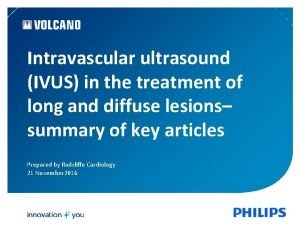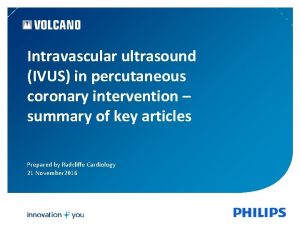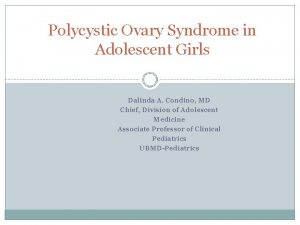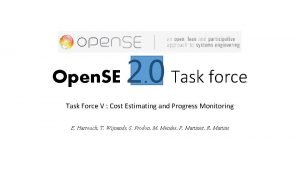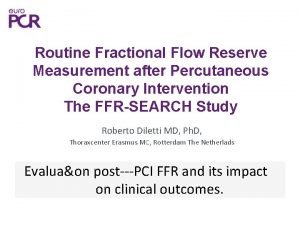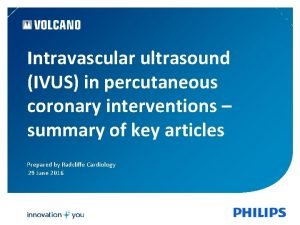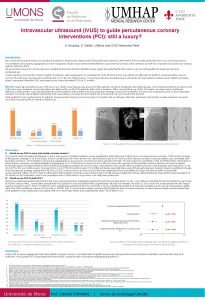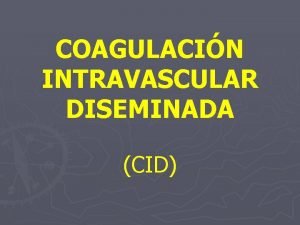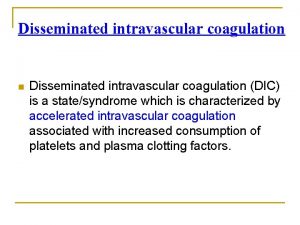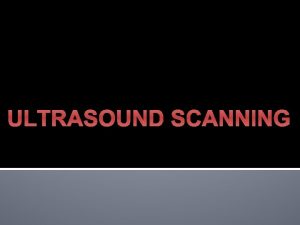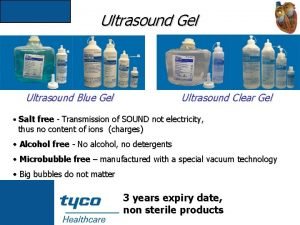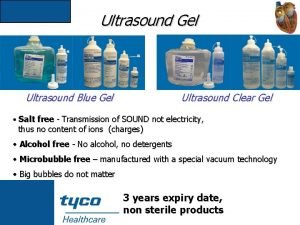Coronary fractional flow reserve derived from intravascular ultrasound













- Slides: 13

Coronary fractional flow reserve derived from intravascular ultrasound imaging (IVUSFR): Validation of a new computational method. Alexandre Hideo-Kajita MD Presenting on behalf of Pedro A. Lemos MD, Ph. D. Cristiano G. Bezerra MD, Ph. D; Alexandre Hideo-Kajita MD; Carlos A. Bulant DSc; Gonzalo D. Maso-Talou DSc; Jose Mariani Jr MD; Fabio A. Pinton MD; Breno A. A. Falcão MD, Ph. D; Antônio Esteves-Filho MD; Marcelo Franken MD, Ph. D; Raúl A. Feijóo DSc; Roberto Kalil-Filho MD, Ph. D; Hector M. Garcia-Garcia MD, Ph. D; Pablo J. Blanco DSc; Pedro A. Lemos MD, Ph. D. March, 3 rd 2019 Bezerra C et al. Catheter Cardiovasc Interv. 2019 Feb 1; 93(2): 266 -274.

Alexandre Hideo-Kajita, MD I have no relevant financial relationships

BACKGROUND / OBJECTIVE BACKGROUND: § The determination of the ischemic status of a coronary artery by wireless physiologic assessment derived from angiography has been validated and approved in the US. § Fractional flow reserve (FFR) and intravascular ultrasound (IVUS) imaging are considered as the “gold standard” for functional and anatomical assessments of angiographic intermediate stenosis, respectively. § A combined method of coronary mathematical blood flow model derived from grayscale IVUS was developed, offering the geometric advantages of IVUS and physiology assessment. OBJECTIVE: § To evaluate the diagnostic performance of IVUSFR compared to FFR.

METHODS Inclusion Criteria § Stable CAD; § Scheduled for elective cardiac catheterization; § Presence of a de novo lesion in at least 1 major epicardial vessel (DS of 40%– 80% by visual estimation); Exclusion Criteria § Left main coronary disease (DS >50%); § Clinical, angiographic or IVUS findings suggesting Acute Disease (thrombus or plaque rupture); § Severe Left ventricular dysfunction; § End-stage Chronic renal disease; § Surgical graft in the target vessel.

METHODS: § Acquisition and Offline analysis - IVUS, Angio and FFRINVASIVE • Heart Institute (In. Cor) - University of São Paulo, SP, BR • Sirio-Libanes Hospital - São Paulo, SP, BR § Data post processing - 3 D-IVUS mesh and IVUSFR • Blinded Comparison between IVUSFR and FFRINV. National Laboratory for Scientific Computing (LNCC) * The study protocol is approved by the ethics committees of the centers and is in accordance with the Helsinki Declaration.

ACQUISITION Stable CAD Patients Angiographic assessment* (Intermediate lesion) * Same procedure. + IVUS* + FFR* DATA PROCESSING 24 patients (34 lesions/vessels) In. Cor IVUS, Angio and FFR 3 D IVUS and IVUSFR FFR versus IVUSFR (n = 34 lesions) LNCC

3 D mesh of a coronary artery based on Grayscale IVUS Acquisition Orthogonal views Projection A Projection B Grayscale IVUS Coronary Angio Gating Segmentation Reconstruction

ACTUAL CASE Angio + FFRINVASIVE %DS = 60 FFRINVAS = 0. 91 IVUSFR = 0. 91

RESULTS Table 1: Baseline characteristics. (n = 24) 59. 4 (53. 0– 68. 3) 21 (87. 5%) 27. 5 (25. 2– 30. 6) Age (years) Male Body mass index (kg/m 2) Risk Factors Hypertension 15 (62. 5%) Current smoker 9 (37. 5%) 10 (41. 7%) Diabetes mellitus Previous PCI 2 (8. 3%) Previous CABG 1 (4. 2%) Clinical presentation Stable Angina 8 (33. 3%) Silent ischemia 16 (66. 7%) 64. 5 (62. 0– 68. 0) Left ventricle ejection fraction (%) Heart rate (bpm) 70. 0 (64. 5– 76. 5) Mean systemic arterial pressure (mm. Hg) 86. 0 (74. 3– 91. 8) Numbers are counts (percentage) or median (interquartile range).

RESULTS Table 2: Lesion Characteristics. (n = 34) Target lesions 5/34 (14. 7%) RCA LMCA 0/34 (0. 0%) 21/34 (61. 8%) LAD 8/34 (23. 5%) LCx 13/34 (38. 2%) Eccentric lesions Calcification (moderate/severe) 7/34 (20. 6%) Tortuosity (moderate/severe) 13/34 (38. 2%) ACC/AHA Lesion Classification 3/34 (8. 8%) Type A 13/34 (38. 2%) Type B 1 8/34 (23. 5%) Type B 2 10/34 (29. 4%) Type C FFRINVASIVE 0. 89 (0. 80– 0. 95) Lesion length (mm), mean±SD 10. 6± 5. 4 Reference vessel diameter (mm), median(IQR) 2. 9 (2. 5– 3. 3) Minimum lumen diameter (mm), median(IQR) 1. 6 (1. 4– 2. 0) IVUS MLA (mm 2), median(IQR) 3. 6 (2. 9– 5. 1) 2 IVUS external elastic membrane area (mm ), median(IQR) 12. 1 (9. 1– 16. 1) IVUS plaque burden (%), median(IQR) 67. 0 (60. 8– 74. 3) Numbers are counts (percentage) or median (interquartile range).

RESULTS

RESULTS

LIMITATIONS / CONCLUSION LIMITATIONS: § An exploratory study with small sample size. § The IVUSFR version used in this analysis was still an offline tool. § High computational time/cost. CFD was used to derive flow in this IVUSFR version. CONCLUSION: § The computational processing of IVUSFR showed satisfactory agreement with FFRINVASIVE enriching the anatomical information of grayscale IVUS.
 Ivus
Ivus Intravascular ultrasound
Intravascular ultrasound Ferriman–gallwey score
Ferriman–gallwey score Fractional reserve banking example
Fractional reserve banking example Fractional reserve banking system
Fractional reserve banking system Fractional reserve banking example
Fractional reserve banking example Expansionary money policy examples tagalog
Expansionary money policy examples tagalog Fractional reserve banking example
Fractional reserve banking example Fractional reserve theory
Fractional reserve theory Fractional reserve banking example
Fractional reserve banking example Difference between capital reserve and reserve capital
Difference between capital reserve and reserve capital Contingency reserve vs management reserve
Contingency reserve vs management reserve Difference between capital reserve and reserve capital
Difference between capital reserve and reserve capital Coronary blood flow
Coronary blood flow
